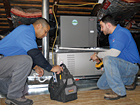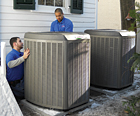
Space
constraints were an issue for the new furnaces, and all the existing ductwork
in the Hopper House had to be removed and replaced.
This summer, the general public will be able to view some of these realistic paintings in the home in which the artist was born and started creating his great works of art. The 2,400-square-foot house was built by Hopper’s maternal grandfather in 1858 and served as the artist’s primary residence until 1910. After Hopper’s death, the house became dilapidated until members of the local community saved the structure from demolition and subsequently restored it. Since 1971, the Edward Hopper House has been a non-profit organization listed on the National Register of Historic Places.
In celebration of its 40th anniversary as a non-profit center, the Edward Hopper House will exhibit some of the painter’s early works, which are on loan from the Whitney Museum of American Art, New York. But before the exhibition could take place, the home first had to meet the stringent climate control requirements of the Whitney Museum.

Eric
Buchalter, second from left, designed the new HVAC system for the Hopper House,
and stands in front of the museum with his team from Design
Air.
OF A SENSITIVE NATURE
Artwork is extremely sensitive to fluctuations in the environment and the existing HVAC systems in the Hopper House could not maintain the strict temperature and humidity guidelines for the exhibition, as well as accommodate the large numbers of visitors expected.The home had old windows and no insulation, which is not ideal given its location in an area that experiences hot, humid summers, cold winters, and damp fall and spring seasons. A gas-fired furnace serviced the entire building through very crude ductwork that had no return system, while window air conditioners were used for cooling, and there was no humidity control.
Enter Eric Buchalter, president, Design Air Inc., Hillburn, N.Y., who was asked to design a system that would protect Hopper’s masterpieces while retaining all of the historic aspects of the home and keep a varying number of visitors comfortable. Numerous other requirements needed to be considered for various areas of the house.

The
downstairs of the Hopper House displays the artist’s works, which require
strict temperature and humidity control.
In addition, the new HVAC system had to have the ability to stage and modulate capacity in relation to the changing conditions: from no people load - just keeping the proper environment for the artwork - to 60 people in the space with the doors to outside constantly opening and closing. The thermostat controls also needed to be user-friendly, provide service messages, and control both temperature and humidity.

Karlos
Batista (left) and Chris DeCaprio of Design Air finish up their installation of
Lennox XC21 units at the Hopper House.
SYSTEM SOLUTIONS
These requirements would be a challenge for any contractor, but Buchalter designed a solution that met the needs of the entire home. For the downstairs of the historic house and gallery space, Buchalter specified a Lennox XC21 air conditioner to help provide consistent comfort, quiet operation, and dehumidification while addressing fluctuating room occupancy and outdoor temperature swings. The quiet operation of the condensing units was particularly important as the equipment is located under the windows of the gallery viewing space.Buchalter specified a Lennox SLP98 gas furnace for its heating efficiency, as well as its low profile, which fit perfectly in the space-constrained basement. A Healthy Climate PureAir MERV 16 air purification system provides museum-quality filtration to protect the artwork from dust and other indoor contaminants, while a Healthy Climate whole-house dehumidifier provides independent dehumidification to help meet the tight environmental criteria.
“With all the traffic and expensive paintings, the air cleaner was definitely the right choice,” said Buchalter. “The dehumidifier is perfect for the summer months as it will enhance the dehumidifying capacity of the air conditioner and control excessive humidity levels in the space where the paintings are located.”
All of this was easy to wire and set up, said Buchalter, with the addition of the Lennox icomfort Touch® thermostat. “The thermostat configures itself for all the equipment it detects on startup and provides an intuitive touchscreen interface to control the overall system. It was easy to program and coordinate all the system components to work together.”
A second system, which includes a SL280V furnace, XC21 air conditioner, and Healthy Climate humidification and dehumidification solutions, was installed in the attic to serve the needs of the upstairs work spaces and offices. This installation was a bit trickier, as Buchalter had to obtain permission to cut in the ceiling feeds without damaging the fragile aging wood lath and plaster ceilings.
To ensure the new systems would operate efficiently, all the existing ductwork in the Hopper House was removed and replaced. “We routed the duct system along the perimeter of the attic to allow for easy access and more storage. We used the same layout for the ductwork in the basement,” said Buchalter. “As a contractor with Home Performance with Energy Star, we are used to making sure duct systems are tight, so we always seal, mastic, and tape all our ductwork.”
With the new HVAC systems up and running smoothly, the Hopper House was ready in plenty of time to display its famous owner’s masterpieces in a comfortable clean environment that is sure to please museum personnel, as well as visitors to the exhibition.
Publication date:06/20/2011









